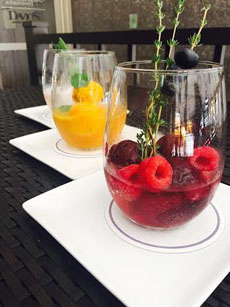Make A Frosé, A Rosé Cocktail. Here’s The Frosé Recipe.
|
We were delighted with this summer refreshment idea from Davio’s Northern Italian Steakhouse. The Frosé combines Davio’s house-made sorbet with rosé wine. It’s a refreshing winetail, a mixed drink made with wine instead of spirits (also see beertail.) You can turn a Frosé into dessert by adding more fruit and less wine. You also can mix different flavors of sorbet. Don’t use a bone-dry rosé, but have the wine store clerk guide you to something with a hint of sweetness*. It will go better with the sorbet and fruit. We used a sparkling rosé and loved it. Use whatever glassware you have on hand, from tumblers to wine goblets. Ingredients Per Drink 1. SCOOP the sorbet into a glass, add the fruit and then top with the rosé. 2. GARNISH and serve with a spoon and a straw. Also referred to as blush wine, rosé can be made as a still, semi-still or sparkling wine. Still rosé wines can be made from almost any red grape varietal, or from a blend of varietals. Sparkling rosé wines, including rosé Champagne, are exceptions because they also can be made with white grapes. The wines get their rosy color from contact with the red grape skins. Depending on the grape, terroir and winemaking techniques, the color can range from the palest pink to deep ruby red to hues of orange or violet. |
[1] For a slushy drink, add the sorbet and fruit to the glass and top with rosé (photo © Peabody Johansen, Culinary Concoctions By Peabody).
|
|
|
Styles range from bone dry Provençal rosé to sweet White Zinfandel and other blush wines from California. Note that rosé wines are not made to age, and should be drunk at 1-3 years old. The exception is top-quality rosé Champagne. A 15-year-old Dom Perignon Rosé, for example, is a joy. The same rootstock that is grown in different locations produces different flavors; for example, depending on where it is grown, Sauvignon Blanc can have grassy or grapefruit notes—or neither. Terroir, pronounced tur-WAH, is a French agricultural term referring to the unique set of environmental factors in a specific habitat that affect a crop’s qualities. It includes climate, elevation, proximity to a body of water, slant of the land, soil type and amount of sun. These environmental characteristics gives the wine its character. Terroir is the basis of the French A.O.C. (Appellation d’Origine Contrôlée) system. *We first made the drink with a sparkling rosé that was as sweet as a soft drink or sweet iced tea. It was too sweet for us. |
||




